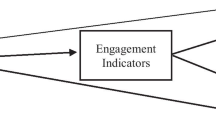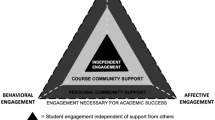Abstract
This study investigated the direct and indirect relationships between participating in a learning community, student engagement, and self-reported learning outcomes. Using a sample of 241 freshmen at a single urban research university who took the College Student Experiences Questionnaire, the results indicate that after controlling for demographic characteristics and entering composite ACT score, the relationship between learning community participation and learning outcomes are mediated by students’ levels of engagement. Learning community participation was not directly related to educational gains but was indirectly related to educational gains through student engagement. Student engagement in turn was strongly related to educational gains.

Similar content being viewed by others
References
Angrist, J. D., Imbens, G. W., & Rubin, D. B. (1996). Identification of causal effects using instrumental variables. Journal of American Statistical Association, 91(434), 444–455.
Angrist, J. D., & Pischke, J. (2009). Mostly harmless econometrics: An empiricist’s companion. Princeton, NJ: Princeton University Press.
Astin, A. (1970). The methodology of research on college impact. Sociology of Education, 43(4), 223–254, 437–450.
Astin, A. (1984). Student involvement: A developmental theory for higher education. Journal of College Student Development, 25(4), 297–308.
Cross, K. (1998). Why learning communities? Why now? About Campus, 3(3), 4–11.
Ethington, C., & Horn, R. (2002). An examination of Pace’s model of student development and college impress. Community College Journal of Research and Practice, 31(3), 183–196.
Gabelnick, F., MacGregor, J., Matthews, R., & Smith, B. (Eds.). (1990). Learning communities: Creating connections among students, faculty, and disciplines (New Directions for Teaching and Learning, no. 41). San Francisco: Jossey-Bass.
Gonyea, R. M., Kish, K. A., Kuh, G. D., Muthiah, R. N., & Thomas, A. D. (2003). College student experiences questionnaire norms for the fourth edition. Bloomington, IN: Indiana University Center for Postsecondary, Policy, and Planning.
Inkelas, K. K., Brower, A. M., Crawford, S., Hummel, M., Pope, D., & Zeller, W. J. (2004, November). National study of living-learning programs: 2004 report of findings. College Park, MD: University of Maryland & Association of College and University Housing Offices International. Retrieved October 16, 2009, from http://www.livelearnstudy.net/additionalresources/reports.html.
Inkelas, K. K., Szelényi, K., Soldner, M., & Brower, A. M. (2007, November). National study of living-learning programs: 2007 report of findings. College Park, MD: University of Maryland. Retrieved October 16, 2009, from http://www.livelearnstudy.net/additionalresources/reports.html.
Johnson, D., Johnson, R., & Smith, K. (1998). Cooperative learning returns to college: What evidence is there that it works? Change, 30, 26–35.
Knight, W. E. (2003). Learning communities and first-year programs: Lessons for planners. Planning for Higher Education, 31(4), 5–12.
Kuh, G. D. (2001a). Assessing what really matters to student learning: Inside the National Survey of Student Engagement. Change, 33(3), 10–17, 66.
Kuh, G. D. (2001b). The National Survey of Student Engagement: Conceptual framework and overview of psychometric properties. Bloomington, IN: Indiana University, Center for Postsecondary Research.
Kuh, G. D. (2008). High-impact educational practices: What are they, who has access to them, and why they matter. Washington, DC: Association of American Colleges and Universities.
Kuh, G. D. (2009). The National Survey of Student Engagement: Conceptual and empirical foundations. In R. Gonyea & G. Kuh (Eds.), Using student engagement data in institutional research (New Directions for Institutional Research Series, no. 141, pp. 5–20). San Francisco: Jossey-Bass.
Kuh, G. D., Schuh, J. H., Whitt, E. J., Andreas, R. E., Lyons, J. W., Strange, C. C., et al. (1991). Involving colleges: Successful approaches to fostering student learning and development outside the classroom. San Francisco: Jossey-Bass.
Pace, C. R. (1979). Measuring outcomes of college: Fifty years of findings and recommendations for the future. San Francisco: Jossey-Bass.
Pace, C. R. (1982, May). Achievement and the quality of student effort. Paper presented at the 1982 Meeting of the National Commission on Excellence in Education in Washington, DC.
Pace, C. R. (1984). Measuring the quality of college student experiences. An account of the development and use of the College Student Experiences Questionnaire. Los Angeles: Higher Education Research Institute.
Pace, C. R. (1985). The credibility of student self-reports. Los Angeles: Center for the Study of Evaluation, University of California Los Angeles.
Pace, C. R. (1998). Recollections and reflections. In J. C. Smart (Ed.), Higher education: Handbook of theory and research (Vol. XIII, pp. 1–34). New York: Agathon Press.
Pace, C. R., & Kuh, G. D. (1998). College Student Experiences Questionnaire (4th ed.). Bloomington, IN: Indiana University Center for Postsecondary Research and Planning.
Pascarella, E. (1985). College environmental influences on learning and cognitive development: A critical review of syntheses. In J. Smart (Ed.), Higher education: Handbook of theory and research (Vol. 1, pp. 1–64). New York: Agathon.
Pascarella, E. (2001). Using student self-reported gains to estimate college impact: A cautionary tale. Journal of College Student Development, 42(5), 488–492.
Pascarella, E., & Terenzini, P. (1991). How college affects students: Findings and insights from twenty years of research. San Francisco: Jossey-Bass.
Pascarella, E., & Terenzini, P. (2005). How college affects students: A third decade of research. San Francisco: Jossey-Bass.
Pedhazur, E. J. (1997). Multiple regression in behavioral research: Explanation and prediction (3rd ed.). South Melbourne, Australia: Wadsworth.
Pike, G. (1999). The effects of residential learning communities and traditional residential living arrangements on educational gains during the first year of college. Journal of College Student Development, 40, 269–284.
Pike, G., Kuh, G., & McCormick, A. (2008, November). Learning community participation and educational outcomes: Direct, indirect and contingent relationships. Paper presented at the 2008 Association for the Study of Higher Education Conference in Jacksonville, FL.
Pike, G., Schroeder, C., & Berry, T. (1997). Enhancing the educational impact of residence halls: The relationship between residential learning communities and first-year college experiences and persistence. Journal of College Student Development, 38, 609–621.
Rocconi, L. M. (2009, May). An application of Pace’s model of student development and college impress on learning community students. Paper presented at the 2009 American Institute of Higher Education Conference in Nashville, TN.
Shapiro, N., & Levine, J. (1999). Creating learning communities: A practical guide to winning support, organizing for change, and implementing programs. San Francisco: Jossey-Bass.
Smith, B. L., MacGregor, J., Matthews, R. S., & Gabelnick, F. (2004). Learning communities: Reforming undergraduate education. San Francisco: Jossey-Bass.
Tinto, V. (1975). Dropout from higher education: A theoretical synthesis of recent research. Review of Educational Research, 45(1), 89–125.
Tinto, V. (1993). Leaving college: Rethinking the causes and cures of student attrition (2nd ed.). Chicago: University of Chicago Press.
Tinto, V. (2000). What have we learned about the impact of learning communities on students? Assessment Update, 12(2), 1–2, 12.
Tinto, V., & Russo, P. (1994). Coordinated studies programs: Their effect on student involvement at a community college. Community College Review, 22(2), 16–25.
Walker, A. (2002). Learning communities and their perceived effect on students’ academic abilities. Paper presented at the Annual Meeting of the American Educational Research Association in New Orleans, LA.
Wolfle, L. M., & Ethington, C. A. (1985). GEMINI: Program for analysis of structural equations with standard errors of indirect effects. Behavior Research Methods, Instruments and Computers, 17, 581–584.
Zhao, C., & Kuh, G. D. (2004). Adding value: Learning communities and student engagement. Research in Higher Education, 45(2), 115–138.
Author information
Authors and Affiliations
Corresponding author
Appendix
Appendix
Items Comprising the Scales Used in the Analysis
Quality of Effort with Students (α = 0.90)
-
Became acquainted with students whose interests were different from yours
-
Became acquainted with students whose family backgrounds (economic, social) was different than yours
-
Became acquainted with students whose age was different from yours
-
Became acquainted with students whose race or ethnic background was different from yours
-
Became acquainted with students from another country
-
Had serious discussions with students whose philosophy of life or personal values were very different from you
-
Had serious discussions with students whose political opinions were very different from yours
-
Had serious discussions with students whose religious beliefs were very different from yours
-
Had serious discussions with students whose race or ethnic background was different from yours
-
Had serious discussions with students from a country different from yours
Quality of Effort with Faculty (α = 0.88)
-
Talked with your instructor about information related to a course you were taking (grades, make-up work, assignments, etc.)
-
Discussed your academic program or course selection with a faculty member
-
Discussed ideas for a term paper or other class project with a faculty member
-
Discussed your career plans and ambitions with a faculty member
-
Worked harder as a result of feedback from an instructor
-
Socialized with a faculty member outside of class (had a snack or soft drink, etc.)
-
Participated with other students in a discussion with one or more faculty members outside of class
-
Asked your instructor for comments and criticisms about your academic performance
-
Worked harder than you thought you could to meet an instructor’s expectations and standards
-
Worked with a faculty member on a research project
Quality of Effort in Coursework (α = 0.85)
-
Completed the assigned readings for a class
-
Took detailed notes during class
-
Contributed to class discussions
-
Developed a role play, case study, or simulation for a class
-
Tried to see how different facts and ideas fit together
-
Summarized majors points and information from your class notes or readings
-
Worked on a class assignment, project, or presentation with other students
-
Applied material learned in a class to other areas (your job or internship, other classes, relationships with friends, family, co-workers, etc.)
-
Used information or experiences from other areas in you life (job, internship, interactions with others) in class discussions or assignments
-
Tried to explain material from a course to someone else (another student, friend, co-worker, family member)
-
Worked on a paper or project where you had to integrate ideas from various sources
Academic Environment (α = 0.79)
-
Emphasis on the development of academic, scholarly, and intellectual qualities
-
Emphasis on the development of aesthetic, expressive, and creative qualities
-
Emphasis on being critical, evaluative, and analytical
Social Environment (α = 0.76)
-
Relationship with other students, student groups, and activities
-
Relationship with administrative personnel and offices
-
Relationship with faculty members
Gains in General Education (α = 0.87)
-
Understanding yourself, your abilities, interests, and personality
-
Developing the ability to function as a member of a team
-
Developing the ability to get along with different kinds of people
-
Learning on your own, pursuing ideas, and finding information you need
-
Learning to adapt to change (new technologies, different jobs or personal circumstances, etc.)
-
Thinking analytically and logically
-
Putting ideas together, seeing relationships, similarities, and differences between ideas
-
Developing your own values and ethical standards
Rights and permissions
About this article
Cite this article
Rocconi, L.M. The Impact of Learning Communities on First Year Students’ Growth and Development in College. Res High Educ 52, 178–193 (2011). https://doi.org/10.1007/s11162-010-9190-3
Received:
Published:
Issue Date:
DOI: https://doi.org/10.1007/s11162-010-9190-3




